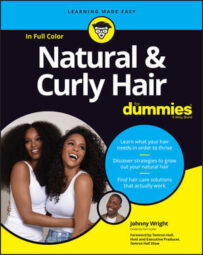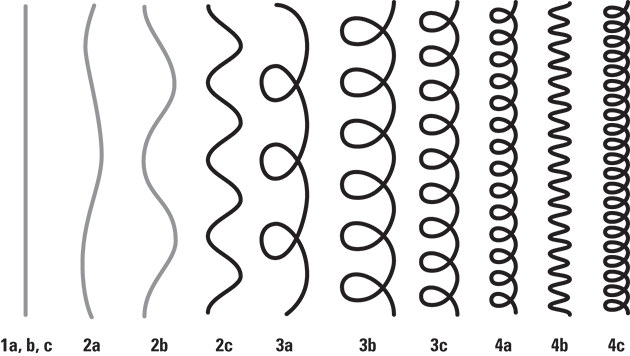 ©Rashell Smith / John Wiley & Sons, Inc.
©Rashell Smith / John Wiley & Sons, Inc.Curls come in all shapes and sizes, and you might even have more than one hair type on your head, so don’t be surprised if you recognize yourself in more than one description. However, most people typically have a dominant hair type, so if your multitextured hair is confusing to you, just focus on the most dominant one (the one you have the most of).
Type 2
Type 2 falls somewhere between straight and curly hair. It’s normally flat at the root of the hair follicle. Most people think of Type 2 hair as wavy, and it ranges from gently tousled textures to S-shape defined waves. You can have fine to coarse Type 2 hair, but it’s typically fine. Here are the three kinds of Type 2 hair:- 2a: Loose, stretched S-shaped waves
- 2b: More distinct S-shaped waves
- 2c: The most defined S-shaped waves that can form loose ringlets and spirals (see the image below)
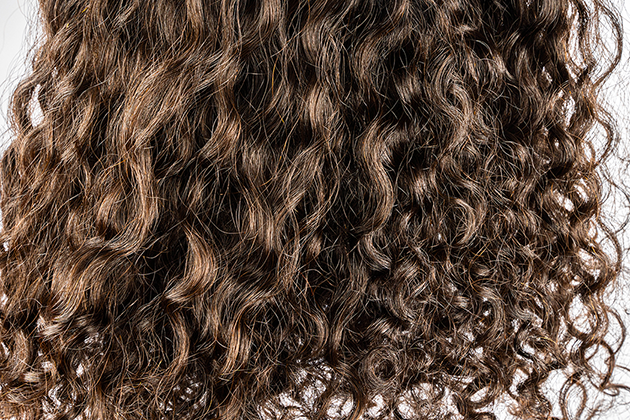 ©KnappyHair Extensions
©KnappyHair ExtensionsOf the three Type 2 subcategories, 2c is the closest to curly hair types, so I want to give you a detailed description of 2c.
Type 2c hair can require a lot of maintenance. Here are a few good habits to help keep your tresses happy and healthy:
- Use a clarifying and volumizing shampoo on wash day. Depending on how oily and weighed down your hair gets, you might want to shampoo twice a week.
- Use a lightweight conditioner, and focus your application of it towards the ends of your hair. Heavy conditioners can cause your hair to fall flat and limp. Alternatively, you can go with a light leave-in conditioner.
- Try products that add moisture and volume/thickness. Volumizing and thickening products help thicken your fine hair without weighing it down.
- Air-dry your hair until it’s about 75 percent dry before you style it. Wet hair is very fragile and can easily break while you pull and stretch it. If you use a diffuser, be sure to dry your hair with your head upside down to create volume at the roots.
- Schedule regular hair trims. Get a trim every six to nine weeks. Because fine hair is so fragile, it tends to split more often. Regular trims prevent your split ends from traveling up the hair shaft.
- Try to limit heat styling. Fine hair is vulnerable to breakage. Because heat styling can accelerate breakage, I don’t advise it.
- Don’t overuse your styling product. Apply your favorite products sparingly. With fine hair, a little goes a long way.
- Choose mid- to shoulder-length hair cuts that use textured layers. Long, fine hair can stretch your curls out, causing your hair to appear much thinner than it actually is. The ends are the oldest part of your strands, so when you leave them on, they are less full. Keeping a shorter hair cut keeps it looking fuller because the hair closest to the root is the newest and thickest.
- Apply protein treatments monthly. Most hair types can benefit from protein treatments. It makes the hair stronger and adds a layer of protection for fragile hair.
Type 3
Type 3 hair is S-shaped curly hair that ranges from springy, tight corkscrew curls to loose, bouncy curls with more volume at the roots (see the image below).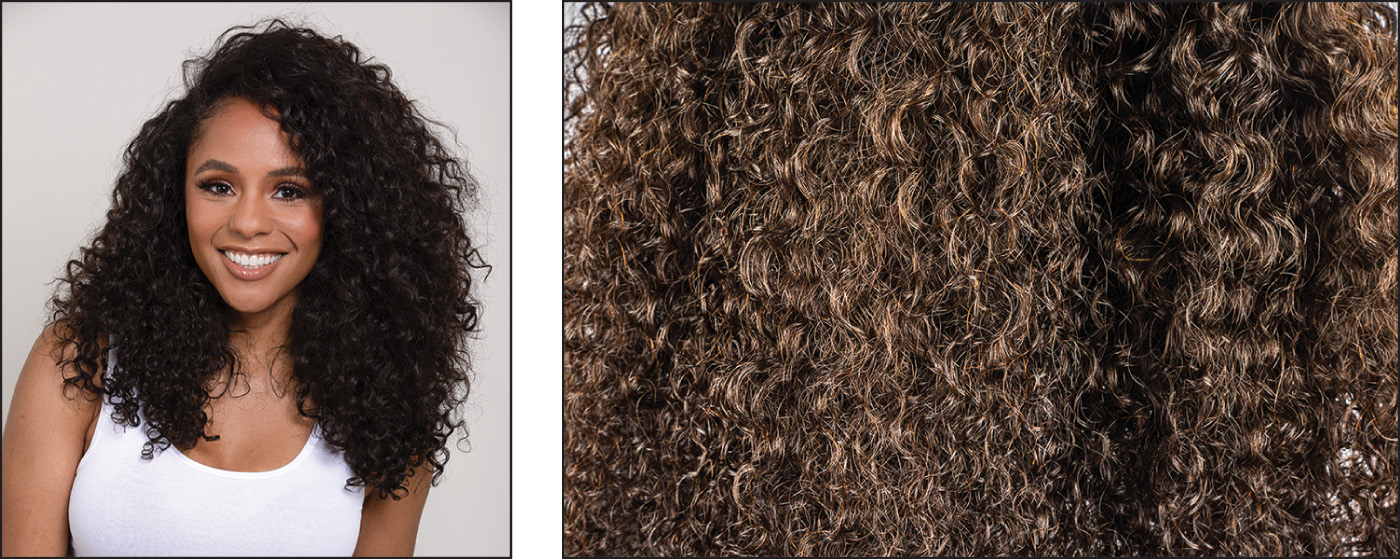 ©Wardell Malloy / crowdMGMT
©Wardell Malloy / crowdMGMTType 3 hair has some shine, but if you don’t give it enough hydration, these curls can have issues with frizz and curl definition (which is how well and clearly you can see the shape and pattern of each curl individually). Type 3 hair can be fine to coarse, but it’s typically medium-textured. Here are the three kinds of Type 3 hair:
- 3a: Big, loose, well-defined spiral curls
- 3b: Bouncy, tighter ringlets and spiral-shaped curls that have a lot of volume
- 3c: Even tighter, corkscrew curls on the verge of Type 4 curls
Type 3 hair is less fragile than Type 2, but you still need to nurture it properly. Here are some good habits to keep them curls poppin’:
- Detangle every wash day. Type 3 hair can be prone to matting if you don’t detangle it before shampooing. Need me to walk you through that process?
- Use traditional shampoos and conditioners once a week. Type 3 hair tends to need more styling products than Type 2, so shampooing weekly prevents buildup. Also, your curls yearn for moisture. Conditioning weekly keeps your moisture balance consistent.
- Schedule regular hair trims. Get a trim every six to nine weeks.
- Switch to deep conditioners or a hair mask every other wash day. You can apply these products in addition to or instead of your traditional conditioner. Deep conditioners and hair masks penetrate deeper into your hair’s cuticle and help prevent frizz, enhance curl definition, hydrate the hair, and restore your curls.
- Add slip with leave-in conditioners. Leave-in conditioners give your curls slip (that means they reduce friction and allow curls to move freely). They also add moisture, making your hair more manageable and easier to detangle.
- Use oils or oil-based styling products. When it comes to moisturizing natural hair, water is the holy grail. Oils and oil-based products help seal and trap moisture in your hair.
Type 4
Type 4 hair has S-shaped or zigzag curls that are very tightly coiled (see the images below). These curls are normally described as coily and kinky. Type 4c hair can shrink more than 50 percent of its actual length when wet.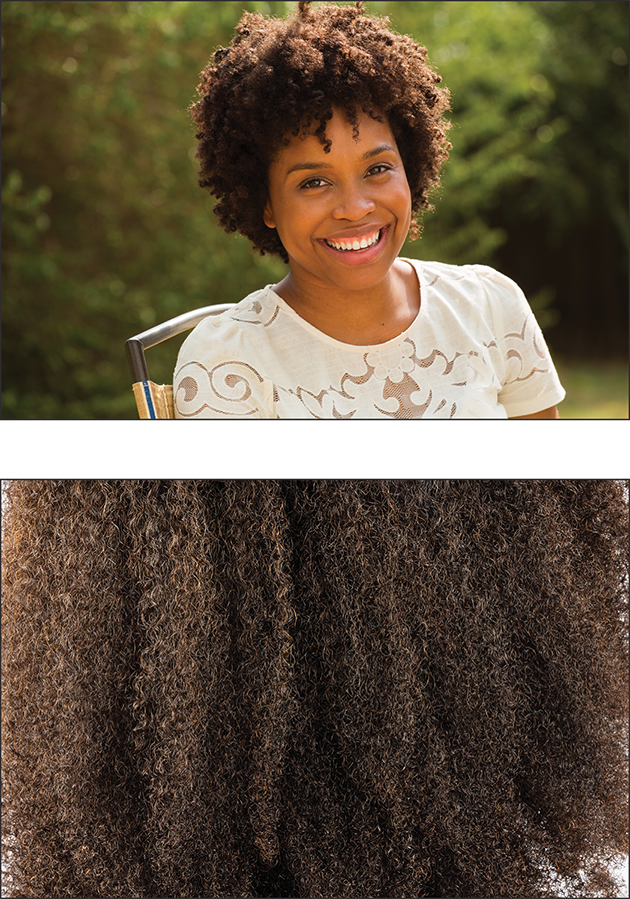 ©digitalskillet 1 / Adobe Stock
©digitalskillet 1 / Adobe StockBecause we’re all uniquely made, 4c hair can have fine to coarse texture. But the most common 4c texture is coarse and may have noticeable curls with less definition. Here are the three kinds of Type 4 hair:
- 4a: Tightly coiled S-shaped curls that begin at the scalp and continue throughout the shaft to the ends
- 4b: More tightly curled than 4a hair, with more of a zigzag curl pattern
- 4c: Super tight zigzag curl patterns with less curl definition
- Detangle first, as always. Detangling is important for all wash day routines. Make sure you detangle your hair to keep it healthy and unmatted.
- Weekly, first detangling your hair, then use a moisturizing shampoo or shampoos formulated for coarse hair. Some shampoos for coarse hair may be listed as sulfate-free.
- Every wash day, use a deep conditioner or hair mask. You can use this deep conditioner either with or instead of your regular conditioner.
- Incorporate steam treatments biweekly with your conditioner, deep conditioner, or hair mask. Steam treatments can moisturize and hydrate all types, but it really helps coarse hair get the extra hydration that it needs.
- Limit using alcohol-based products. Although these products help tame your hair, they can strip hair of moisture. Instead of alcohol-based products, use oils and creams that help seal moisturize and hydrate.
- Use a detangling brush while your hair is wet. Detangling brushes help remove knots, which keeps your hair from breaking and becoming damaged.
- Schedule regular trims. Coarse hair can be prone to split ends because of its tendency to be dry. I recommend getting regular trims every eight to ten weeks.
- Try co-washing biweekly. Co-washing may or may not work for you, but it doesn’t hurt to give it a try.
Sleep with a silk or satin head covering or pillowcase, which protect all hair types. These fabrics reduce friction, frizz, flyaways, and breakage, so you can more easily maintain your curls.

